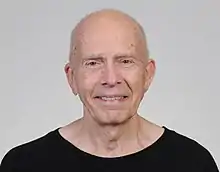Paul Schimmel
Paul Reinhard Schimmel (born 1940) is an American biophysical chemist and translational medicine pioneer.
Paul Schimmel | |
|---|---|
 | |
| Born | August 4, 1940[1] |
| Nationality | American |
| Scientific career | |
| Fields | Biochemistry/Molecular Medicine |
| Doctoral students | Maria Jasin, Lynne Regan |
Career
Paul Schimmel is an Ernest and Jean Hahn Professor of Molecular Biology and Chemistry[2] at The Scripps Research Institute. Prior to joining The Scripps Research Institute, he was a John D. and Catherine T. MacArthur Professor of Biochemistry and Biophysics at MIT (Massachusetts Institute of Technology). Author or coauthor of many scientific research publications,[3] he is also coauthor of a widely used 3-volume textbook on biophysical chemistry.[4] His research interests have focused on aminoacyl tRNA synthetases as fundamental interpreters of the genetic information.[5] Through career-long investigations of this ancient and universal set of essential enzymes, his laboratory has worked on a universal mechanism for correcting errors in the interpretation of genetic information,[6][7] and went on to show how this mechanism is essential for maintaining cellular homeostasis and for preventing serious pathologies and disease.[8][9] His laboratory also discovered what others have referred to as a tRNA synthetase-directed primordial, or ‘second’, genetic code that eventually was incorporated into the modern code.[10][11][12] In a separate line of research published back in 1983, Schimmel developed the concept of what are now known as ESTs (expressed sequence tags) and the strategy of shotgun sequencing, approaches that several years later were adopted for the human genome project.[13] Nature magazine listed Schimmel's work on the development of ESTs as one of the four key developments that launched the human genome project (Nature volume 409, p. 862 (2001)).[14] Lastly, his laboratory established connections of synthetases to disease and, most recently, they reported the structural and functional metamorphosis of these proteins, whereby they are repurposed with novel activities, both inside and outside the cell, in a variety of cell signaling pathways[15][16][17]
Honors
Named to various society and university awards and honorary degrees, and elected to membership in the American Academy of Arts and Sciences,[18] the National Academy of Sciences,[19] the American Philosophical Society,[20] the Institute of Medicine (National Academy of Medicine)[21] and National Academy of Inventors.[22] Active in many scientific and academic organizations and committees, including past service as President of the Division of Biological Chemistry of the American Chemical Society (presently with over 7,000 members) and as an editorial board member of numerous scientific journals. In June 2020, he was named the 2020 winner of the Kathryn C. Hach Award for Entrepreneurial Success for "co-founding more than ten biotech companies and aiding others in their endeavors for nearly three decades."[23]
References
- Who's who in the West: A Biographical Dictionary of Noteworthy Men and Women of the Pacific Coast and the Western States. A.N. Marquis Company. 2001. ISBN 9780837909325. Retrieved 2015-03-24.
- "TSRI Faculty Page".
- "Complete List of Published Work in MyBibliography".
- Cantor, Charles R.; Schimmel, Paul R. "Biophysical Chemistry Part I: The Conformation of Biological Macromolecules, Biophysical Chemistry Part II: Techniques for the Study of Biological Structure and Function, Biophysical Chemistry Part III: The Behavior of Biological Macromolecules". Macmillan Learning.
- "Schimmel Lab Website".
- Schmidt, E.; Schimmel, P. (1994-04-08). "Mutational isolation of a sieve for editing in a transfer RNA synthetase". Science. 264 (5156): 265–267. doi:10.1126/science.8146659. ISSN 0036-8075. PMID 8146659.
- Song, Youngzee; Zhou, Huihao; Vo, My-Nuong; Shi, Yi; Nawaz, Mir Hussain; Vargas-Rodriguez, Oscar; Diedrich, Jolene K.; Yates, John R.; Kishi, Shuji (2017-12-22). "Double mimicry evades tRNA synthetase editing by toxic vegetable-sourced non-proteinogenic amino acid". Nature Communications. 8 (1): 2281. doi:10.1038/s41467-017-02201-z. PMC 5741666. PMID 29273753.
- Lee, Jeong Woong; Beebe, Kirk; Nangle, Leslie A.; Jang, Jaeseon; Longo-Guess, Chantal M.; Cook, Susan A.; Davisson, Muriel T.; Sundberg, John P.; Schimmel, Paul (2006-09-07). "Editing-defective tRNA synthetase causes protein misfolding and neurodegeneration". Nature. 443 (7107): 50–55. doi:10.1038/nature05096. ISSN 1476-4687. PMID 16906134.
- Liu, Ye; Satz, Jakob S.; Vo, My-Nuong; Nangle, Leslie A.; Schimmel, Paul; Ackerman, Susan L. (2014-12-09). "Deficiencies in tRNA synthetase editing activity cause cardioproteinopathy". Proceedings of the National Academy of Sciences of the United States of America. 111 (49): 17570–17575. doi:10.1073/pnas.1420196111. PMC 4267364. PMID 25422440.
- Francklyn, C.; Schimmel, P. (1989-02-02). "Aminoacylation of RNA minihelices with alanine". Nature. 337 (6206): 478–481. doi:10.1038/337478a0. ISSN 0028-0836. PMID 2915692.
- Francklyn, C.; Shi, J. P.; Schimmel, P. (1992-02-28). "Overlapping nucleotide determinants for specific aminoacylation of RNA microhelices". Science. 255 (5048): 1121–1125. doi:10.1126/science.1546312. ISSN 0036-8075. PMID 1546312.
- Schimmel, Paul (January 2018). "The emerging complexity of the tRNA world: mammalian tRNAs beyond protein synthesis". Nature Reviews. Molecular Cell Biology. 19 (1): 45–58. doi:10.1038/nrm.2017.77. ISSN 1471-0080. PMID 28875994.
- Putney, S. D.; Herlihy, W. C.; Schimmel, P. (1983-04-21). "A new troponin T and cDNA clones for 13 different muscle proteins, found by shotgun sequencing". Nature. 302 (5910): 718–721. doi:10.1038/302718a0. ISSN 0028-0836. PMID 6687628.
- Lander, E. S.; Linton, L. M.; Birren, B.; Nusbaum, C.; Zody, M. C.; Baldwin, J.; Devon, K.; Dewar, K.; Doyle, M. (2001-02-15). "Initial sequencing and analysis of the human genome" (PDF). Nature. 409 (6822): 860–921. doi:10.1038/35057062. ISSN 0028-0836. PMID 11237011.
- Guo, Min; Schimmel, Paul (March 2013). "Essential nontranslational functions of tRNA synthetases". Nature Chemical Biology. 9 (3): 145–153. doi:10.1038/nchembio.1158. PMC 3773598. PMID 23416400.
- Sajish, Mathew; Schimmel, Paul (2015-03-19). "A human tRNA synthetase is a potent PARP1-activating effector target for resveratrol". Nature. 519 (7543): 370–373. doi:10.1038/nature14028. PMC 4368482. PMID 25533949.
- Lo, Wing-Sze; Gardiner, Elisabeth; Xu, Zhiwen; Lau, Ching-Fun; Wang, Feng; Zhou, Jie J.; Mendlein, John D.; Nangle, Leslie A.; Chiang, Kyle P. (2014-07-18). "Human tRNA synthetase catalytic nulls with diverse functions". Science. 345 (6194): 328–332. doi:10.1126/science.1252943. PMC 4188629. PMID 25035493.
- "American Academy of Arts and Sciences".
- "National Academy of Sciences".
- "American Philosophical Society".
- "National Academy of Medicine".
- "National Academy of Inventors".
- "2020 National Award Recipients Citations". American Chemical Society. Retrieved 2020-06-13.